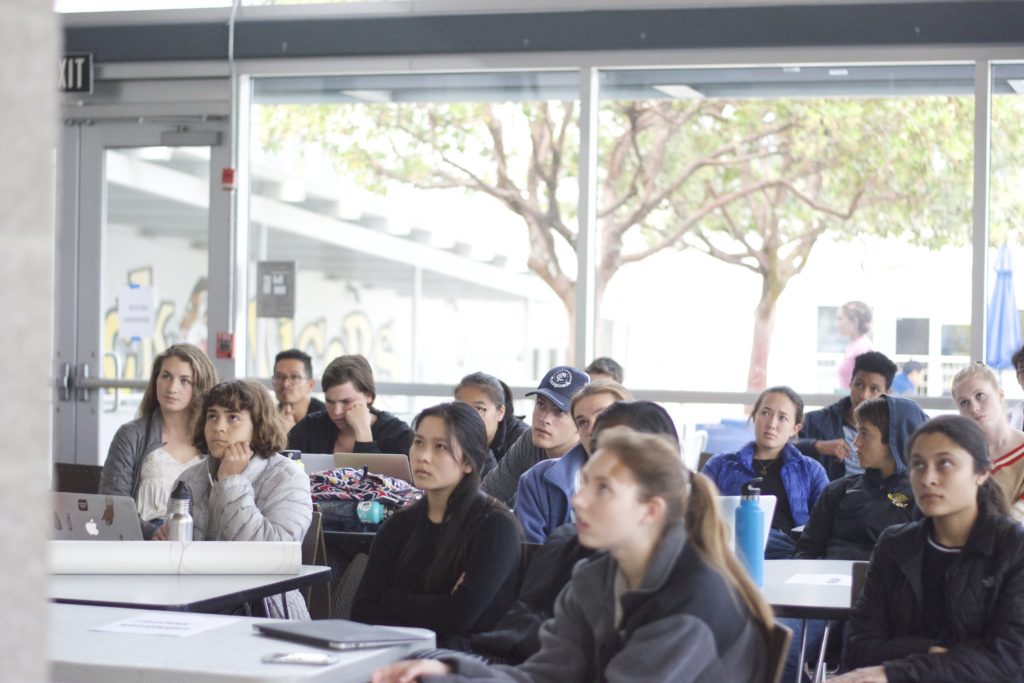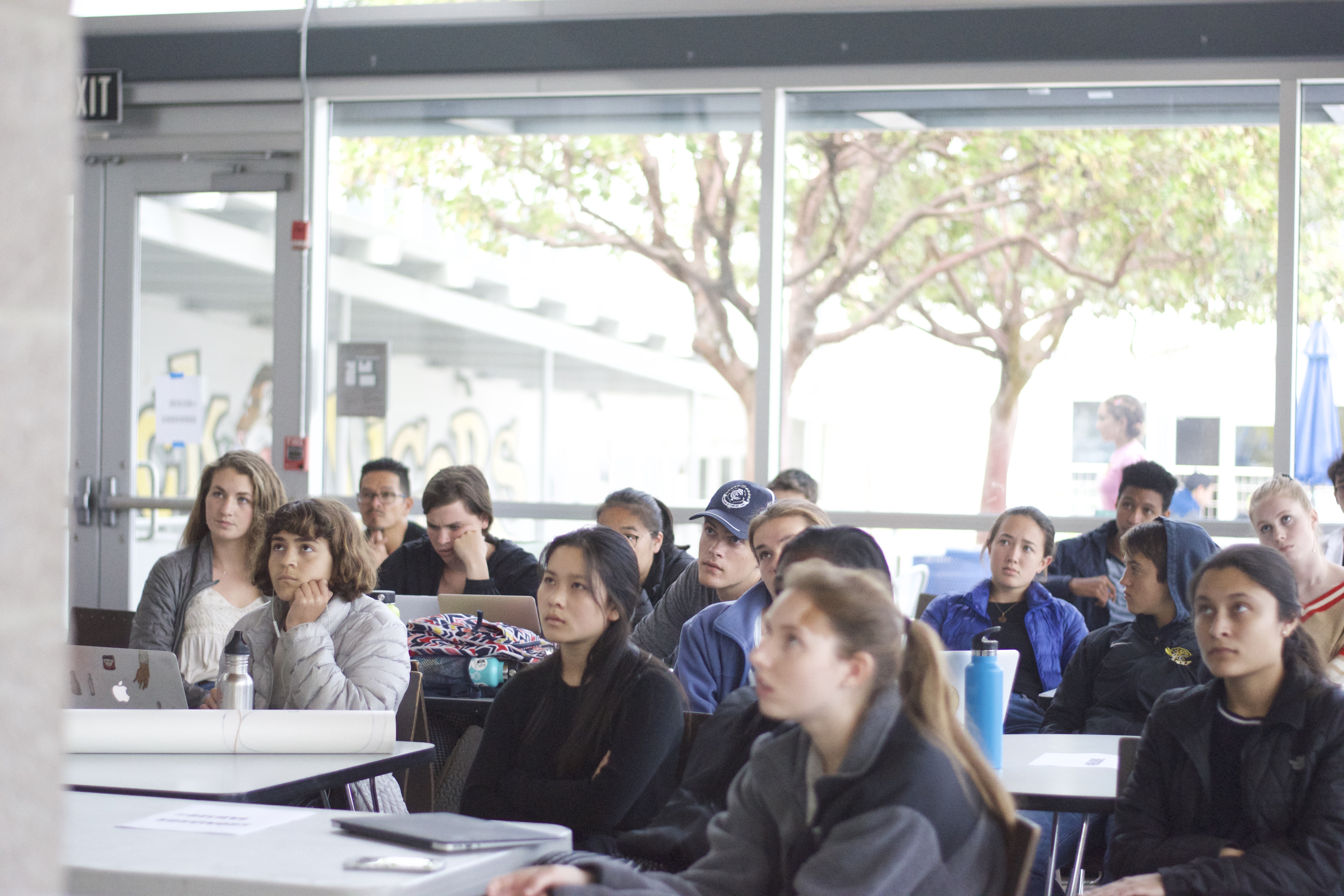
photo by Nick Harris
On December 18, 2017, Judge Alex Kozinski stepped down from his position on the 9th Court of Appeals. He stood accused of years of brazen sexual harassment, from calling female employees into his office to show them pornography to repeatedly suggesting that a female law clerk should work out naked. Yet it had taken decades for Kozinski to be taken to task for his actions, because of his prominence in the legal world. In particular, he was known as a “feeder judge,” whose clerks (law students who interned as assistants to the judge) went on to clerk for Supreme Court Justices, and thus to consistently high-profile careers.
One of those clerks was now-Supreme Court Justice Brett Kavanaugh. “I think I’ve come to realize, much to my own shock… that there are quite entrenched gender imbalances” in law, says Tiffany Lee ‘02, Assistant Attorney General for the State of Washington. Indeed, with almost as many members of the Supreme Court accused of sexual harassment or assault (Justices Kavanaugh and Clarence Thomas) as female judges (Justices Sonia Sotomayor, Elena Kagan, and Ruth Bader Ginsburg), it is worth examining the impact of hostile gender dynamics on the system of law.
When Alicia Fenrick, a top litigator for Pacific Gas and Electric, entered law, sexual harassment “just wasn’t something we felt like we could talk about. If someone noticed you, you had to find ways of not letting it derail your career.” She describes a male co-worker ignoring her request to leave her alone. “He thought it was funny. He didn’t care at all that I was finding his behavior unacceptable. When I suggested that I was maybe going to talk to the managing partner about it, he laughed, because he knew that I wouldn’t. He knew that I didn’t want to risk my job, I didn’t want to be the troublemaker.”
In large law firms with bureaucratic methods for promotion, the added barriers that female lawyers face in talking with their bosses may hamper their career prospects. According to a study by Law360, 35 percent of the lawyers at law firms are female, but women make up only 24 percent of partners and 12 percent of those in top leadership positions. “You can do really well as a female up until year four, five, six, or seven” at a law firm, says Lee. When it comes to promotion, though, “I think oftentimes folks like to sponsor those who they see as copies of themselves.”
Luckily, the situation may be improving — 42 percent of lawyers promoted to be partners were female in 2017, per Law360 — but obstacles unique to women still exist. For example, Lee says, while “a male partner can very easily have dinner with a male associate and have no questions… there might be issues of perception and fear” if he dined with a female associate. (One common form of sexual harassment is male bosses repeatedly asking female employees on dates; in fact, Anita Hill described such behavior on the part of Thomas during his confirmation hearings in 1991.)
Denied full access to the systems of power, female lawyers may be forced to find creative solutions to sexism at work. Instead of contacting the managing partner, Fenrick found the phone number of her co-worker’s wife, and told him that she would call if he did not change his attitude. “That seemed to do the trick,” she says.
Similarly, when Lee became pregnant, it was help from outside the system that kept her career moving forward. Many of her fellow lawyers “had stay-at-home wives, and they thought that once I got pregnant, I was going to quit my job and stay home with the kids.” A female client noticed the firm increasingly sidelining Lee, and gave her a case to bring to the firm, an unusual circumstance for an employee with so little seniority. “There was no expectation that I would bring in any sort of business,” Lee says. “She threw me a bone.”
Some areas of law are worse than others. Lee names employment law and government as two fields that are more heavily female, and non-profit law belongs on that list as well, according to Phyllida Burlingame, director of Reproductive Justice and Gender Equity at the American Civil Liberties Union of Northern California. She notes that “so much of the groundbreaking advocacy we’re seeing” is due to the “many, many women in leadership in the non-profit legal world.”
Still, it should come as a concern that “power and privilege are passed down and reinforced in elitist spaces” in the legal world, says Burlingame. Notably, all nine Supreme Court Justices attended either Harvard or Yale for law school. Professors like Yale’s Amy Chua, who reportedly told her students that then-Judge Kavanaugh liked “a certain look” in his female law clerks, can make or break the futures both of individual students and of the United States itself. Though Kavanaugh himself has actually worked contrary to some patterns, taking on more female clerks than male, the top echelons of legal society — the ones that exercise the most power over Americans’ lives — may feature the most inequitable distributions of power.
These questions are not merely academic. On the Supreme Court, Kavanaugh will rule on cases covering a wide range of issues related to women’s reproductive health. In previous court decisions and public statements, he has referred to “abortion-inducing drugs” and “abortion on demand,” two terms that Burlingame says are “straight out of the [pro-choice] playbook.” She says that “by opposing both abortion and contraception, what you’re opposing is the autonomy and the dignity of people to make their own decisions about their bodies… there’s a throughline there” to the accusations of sexual assault.
As the recent hearings on Dr. Christine Blasey Ford’s allegation that Kavanaugh sexually assaulted her in high school demonstrate, sexual violence in the public eye has less tangible impacts on society, as well. “If a young girl is devalued to the point that it doesn’t matter what happens to her, it doesn’t matter if” — as Dr. Ford alleges — “she was held down and her clothes were attempted to be ripped off… that’s problematic,” says Shael Norris, executive director of SafeBae, an advocacy organization focused on teen sexual assault. On the day of Dr. Ford’s testimony, calls to the Rape, Incest, and Abuse National Network’s hotline increased by a whopping 201 percent. At least 20% of televisions in the United States were tuned to the hearing, and from hour to hour, the three largest television news networks averaged over 10 million viewers. The moment in history seems likely to leave a lasting memory for millions of Americans, as did Anita Hill’s testimony during Justice Clarence Thomas’ confirmation process 27 years ago.
Burlingame says she spent Dr. Ford’s testimony texting with a friend with whom she had watched Hill’s hearing. She remembers “being glued to the TV watching the hearing with an increasing sense of despair and outrage. [Hill] was credible. She was extremely composed. She was coming forward out of a sense of civic duty. And she was blasted.”
“It disgusted me,” agrees Fenrick. “To see how disrespected and ignored [Hill] was, this brilliant, elegant, and graceful woman, being so insulted and diminished… it further solidifies why people didn’t speak up.” Thomas, like Kavanaugh, was confirmed by the Senate in a closely contested vote. “You get humiliated, you get disrespected, and at the end of the day, no one cares,” Fenrick adds.
It’s unclear how significantly attitudes towards sexual harassment and assault have changed in the subsequent generation. “Anita Hill’s hearing was much more of a character assassination,” says Lee, who identifies as a survivor of sexual assault. “It was heartening in some ways to see that the way that they were questioning Dr. Ford was much more victim-centered.” Also important to consider is that Dr. Ford may have received preferable treatment from the Senate Judiciary Committee (which is responsible for screening Supreme Court nominees) due to her race — Dr. Ford is white, and Hill is black. That matches with Fenrick’s experience as a young lawyer. “It is hard for me to tell what happened because I am black, and what happened because I am a woman,” she says.
Furthermore, University of Wisconsin polling that asked the same questions in 1991 and 2018 indicates that political opinions of the two nominations haven’t shifted in one direction or the other, just become more polarized. When asked if, should the allegations against them be proven true, the Senate should support Thomas’ or Kavanaugh’s nominations, essentially the same percentage of Americans replied that they should vote the candidate down (67 percent in 1991 and 69 percent in 2018). Strikingly, though the proportions of support and opposition towards Senators who helped to confirm Kavanaugh were close to identical, the number of undecided respondents dropped dramatically — from 67 percent in 1991 to only 28 percent in 2018. The American public does not appear to have changed its attitudes towards sexual assault in the last generation, but it does seem to hold those attitudes more loudly and fervently than it did before.
Still, at least anecdotally, understanding of consent seems a bit more widespread than in the era of the Anita Hill hearings. “It’s not surprising that [Kavanaugh] and other people in the room didn’t understand it as rape,” says Norris. In the 1980s, when the alleged assaults occurred, “nobody understood rape as anything other than a stranger jumping out from behind the bushes and hitting you over the head.”
“It was a different social time,” says Fenrick, who graduated from college only four years after Kavanaugh. “If [a woman] was inebriated, then she was fair game for all kinds of things.”
As sexual education improves, advocates hope that a stronger focus on communication can prevent the next Brett Kavanaugh-like high schooler from committing sexual assault. The ability to communicate in a sexual relationship is even more important. “It’s not just about consent. It’s about if both people in the room are conscious of each other’s pleasure,” Norris says. A good consent program should include “a real opportunity to practice communication skills and decision-making, and an analysis of power, and how power can intervene in relationships and create problems,” says Burlingame, whose professional background is also in sexual education.
The culture of the field of law, presumably, will change along with American society as a whole. Law students at Yale walked out of class in protest of Kavanaugh’s confirmation process, and students who write for Harvard’s prestigious law review successfully pushed for the school to suspend Kavanaugh’s position as a paid lecturer. To Fenrick, who attended Harvard Law School, “it speaks volumes that our newest to-be lawyers are concerned about what the Supreme Court looks like.”
For Lee, her involvement in a campaign to change her university’s sexual assault policies was what convinced her to go into law. “I realized that a good number of people around me have been through what I’ve been through, and didn’t speak up,” she says. “I enjoy the policy aspects of being a lawyer, [and] I realized that I wanted to advocate for people.”






